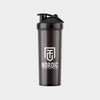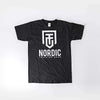What are elbow sleeves?
Our elbow sleeves, also called elbow warmers, are made of high quality neoprene material with a thickness of 5-7 mm. Our elbow warmers create compression and warmth, which in turn increases blood circulation in the elbows and arm muscles. They are often used when the elbows are exposed to stress, e.g. for bench press and shoulder press.
What are the benefits of elbow sleeves?
One of the main reasons why our elbow sleeves are popular is that they prevent injuries and create stability for muscles and joints. They help you perform with better control and stability during your workouts. Our elbow warmers are also used to give you pain relief and relieve discomfort. You can also use them after your workouts to help you in your recovery process by reducing swelling and minimizing pain.
Some of our favorite benefits that our elbow warmers provide:
- Better protection:
Discomfort, general aches and elbow pain can be irritating. Our elbow sleeves create protection through their warming compression functions and reduce discomfort caused by tendinitis, golf elbow, tennis elbow, mouse arm, arthritis and more. In addition, our elbow warmers are excellent for protecting your arm muscles and tendons during your heaviest press exercises.
- Regulation of body temperature:
Our elbow sleeves help to regulate your body temperature, which is very useful in outdoor sports and activities, especially during the winter. The compression that our elbow warmers provide works by the body, moderating blood flow and increasing circulation.
- Better recovery:
Our elbow sleeves also improve your recovery, as they reduce pain and swelling in your elbows. Both during and after your workout, you can use our elbow warmers. During your heaviest workout, they will increase circulation, allowing your muscles to recover faster.
What size should you have for elbow sleeves?
A properly fit on our elbow warmers is the best, because too tight fit can have the opposite effect by restricting blood flow and too loose fitting does not give you the compression you need. The perfect size of our elbow sleeves is when it feels comfortable, the material breathes and that they do not limit you in your training.
The easiest way to measure to get the right fit on your elbow warmers:
- Measure with a measuring tape. If you do not have it on hand, a ruler also works together with a string.
- Start by keeping your arm outstretched and relaxed.
- If you are using a tape measure, measure around the forearm where your elbow sleeves will begin and measure around the upper arm where they will end.
- If you use a string, do the same, but measure the length of the string with a ruler afterwards.
- Once you have found the right size, compare with ours size chart.
Use elbow supports in your training
Elbow supports, or elbow sleeves, can be a valuable part of your training equipment, especially if you want to prevent injuries and improve your performance. There are several reasons why one might use elbow supports during training, and we will go through the most important pros and cons, as well as discuss when it might be appropriate to use them at the gym.
One of the biggest advantages of elbow supports is that they offer support and stability to the elbow joint during intense workouts, which can help to reduce the risk of injury. They work by providing compression and warmth, which reduces swelling and inflammation, and improves blood circulation in the area. This can be particularly advantageous for individuals who have a history of elbow injuries or who experience pain during training.
Another benefit of elbow supports is that they can enhance your technique and execution of exercises, particularly in weightlifting and other strength training activities. By offering additional support and stability, elbow supports can help you maintain correct form and minimize the risk of incorrect movements that can lead to injury.
However, there are some disadvantages to consider when it comes to using elbow supports. One of these is that they can give a false sense of security and make you lift heavier weights than you would normally be able to do without the support. This could potentially increase the risk of injury if you are not careful. Additionally, overuse of elbow supports can lead to the muscles around the elbow joint becoming weaker, as they do not need to work as hard to stabilize the joint.
In conclusion, elbow supports can be a useful tool to prevent injuries and improve performance during training, but it is important to use them correctly and understand their pros and cons. Explore our range of elbow supports and find the perfect product for your individual training needs.
Stable elbow supports for the gym
Elbow supports are an excellent training tool that can help you improve your performance and reduce the risk of injuries when training at the gym. They can be particularly useful in certain exercises where the elbow joint is subjected to high stress or when you need extra support to prevent overloading and injuries.
Some of the exercises where elbow supports can be beneficial include:
- Bench Press: Elbow supports can help stabilize the elbow joint and provide support during the negative phase of the movement. This can reduce the risk of injuries and improve your technique.
- Push-ups: If you have difficulty with push-ups due to weak elbows or previous injuries, elbow supports can help you perform the exercise with better form and less pain.
- Dips: Elbow supports can provide extra support when you perform dips and help reduce the strain on the elbow joint, which can prevent overloading and injuries.
- Barbell Rows: When performing barbell rows or similar exercises that involve a movement where the elbow is bent and extended under load, elbow supports can help stabilize the elbow joint and improve technique.
- Chin-ups and Pull-ups: In these exercises, where upper body strength is crucial, elbow supports can help reduce the strain on the elbow joint and improve your ability to perform more repetitions.
No matter what type of exercises you perform at the gym, elbow supports can be a valuable addition to your training routine to improve performance and reduce the risk of injuries.
 Lifting Straps
Lifting Straps Lifting Belts
Lifting Belts Nordic Grips
Nordic Grips Knee Sleeves
Knee Sleeves Elbow Sleeves
Elbow Sleeves Wrist Wraps
Wrist Wraps Knee Wraps
Knee Wraps Smelling Salt
Smelling Salt Supplements
Supplements  Neoprene Shorts
Neoprene Shorts Grip Shirt
Grip Shirt Deadlift socks
Deadlift socks Gym Chalk
Gym Chalk  Lifting Shoes
Lifting Shoes Strongman Tacky
Strongman Tacky Stone Sleeves
Stone Sleeves Sandbags
Sandbags Calf & Shin Sleeves
Calf & Shin Sleeves Compression Cuffs
Compression Cuffs Accessories
Accessories
 Best Seller
Best Seller Sale
Sale News
News Lifting Straps
Lifting Straps Lifting Belts
Lifting Belts Nordic Grips
Nordic Grips Knee Sleeves
Knee Sleeves Elbow Sleeves
Elbow Sleeves Wrist Wraps
Wrist Wraps Knee Wraps
Knee Wraps Smelling Salt
Smelling Salt Supplements
Supplements  Neoprene Shorts
Neoprene Shorts Grip Shirt
Grip Shirt Deadlift socks
Deadlift socks Gym Chalk
Gym Chalk  Lifting Shoes
Lifting Shoes Strongman Tacky
Strongman Tacky Stone Sleeves
Stone Sleeves Sandbags
Sandbags Calf & Shin Sleeves
Calf & Shin Sleeves Compression Cuffs
Compression Cuffs Accessories
Accessories



 Lifting Straps
Lifting Straps Lifting Belts
Lifting Belts Nordic Grips
Nordic Grips Knee Sleeves
Knee Sleeves Elbow Sleeves
Elbow Sleeves Wrist Wraps
Wrist Wraps Knee Wraps
Knee Wraps Smelling Salt
Smelling Salt Neoprene Shorts
Neoprene Shorts Grip Shirt
Grip Shirt Deadlift socks
Deadlift socks Lifting Shoes
Lifting Shoes Strongman Tacky
Strongman Tacky Stone Sleeves
Stone Sleeves Sandbags
Sandbags Calf & Shin Sleeves
Calf & Shin Sleeves Compression Cuffs
Compression Cuffs Accessories
Accessories







